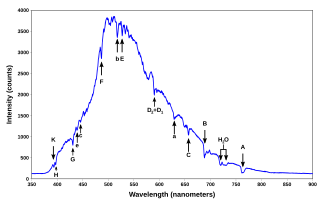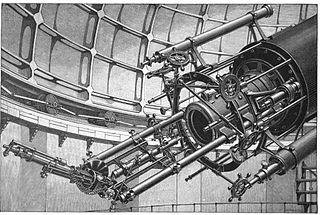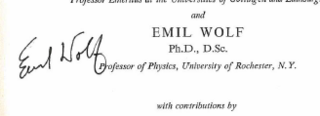The Doppler effect is the change in the frequency of a wave in relation to an observer who is moving relative to the source of the wave. The Doppler effect is named after the physicist Christian Doppler, who described the phenomenon in 1842. A common example of Doppler shift is the change of pitch heard when a vehicle sounding a horn approaches and recedes from an observer. Compared to the emitted frequency, the received frequency is higher during the approach, identical at the instant of passing by, and lower during the recession.

In physics and general relativity, gravitational redshift is the phenomenon that electromagnetic waves or photons travelling out of a gravitational well lose energy. This loss of energy corresponds to a decrease in the wave frequency and increase in the wavelength, known more generally as a redshift. The opposite effect, in which photons gain energy when travelling into a gravitational well, is known as a gravitational blueshift. The effect was first described by Einstein in 1907, eight years before his publication of the full theory of relativity.
Redshift is a phenomenon in physics, especially astrophysics

In physics, a redshift is an increase in the wavelength, and corresponding decrease in the frequency and photon energy, of electromagnetic radiation. The opposite change, a decrease in wavelength and simultaneous increase in frequency and energy, is known as a blueshift, or negative redshift. The terms derive from the colours red and blue which form the extremes of the visible light spectrum. The main causes of electromagnetic redshift in astronomy and cosmology are the relative motions of radiation sources, which give rise to the relativistic Doppler effect, and gravitational potentials, which gravitationally redshift escaping radiation. All sufficiently distant light sources show cosmological redshift corresponding to recession speeds proportional to their distances from Earth, a fact known as Hubble's law that implies the universe is expanding.

The visible spectrum is the portion of the electromagnetic spectrum that is visible to the human eye. Electromagnetic radiation in this range of wavelengths is called visible light or simply light. A typical human eye will respond to wavelengths from about 380 to about 750 nanometers. In terms of frequency, this corresponds to a band in the vicinity of 400–790 terahertz. These boundaries are not sharply defined and may vary per individual. Under optimal conditions these limits of human perception can extend to 310 nm (ultraviolet) and 1100 nm . The optical spectrum is sometimes considered to be the same as the visible spectrum, but some authors define the term more broadly, to include the ultraviolet and infrared parts of the electromagnetic spectrum as well.

A spectral line is a weaker or stronger region in an otherwise uniform and continuous spectrum, resulting from emission or absorption of light in a narrow frequency range, compared with the nearby frequencies. Spectral lines are often used to identify atoms and molecules. These "fingerprints" can be compared to the previously collected ones of atoms and molecules, and are thus used to identify the atomic and molecular components of stars and planets, which would otherwise be impossible.

Astronomical spectroscopy is the study of astronomy using the techniques of spectroscopy to measure the spectrum of electromagnetic radiation, including visible light, ultraviolet, X-ray, infrared and radio waves that radiate from stars and other celestial objects. A stellar spectrum can reveal many properties of stars, such as their chemical composition, temperature, density, mass, distance and luminosity. Spectroscopy can show the velocity of motion towards or away from the observer by measuring the Doppler shift. Spectroscopy is also used to study the physical properties of many other types of celestial objects such as planets, nebulae, galaxies, and active galactic nuclei.

The relativistic Doppler effect is the change in frequency, wavelength and amplitude of light, caused by the relative motion of the source and the observer, when taking into account effects described by the special theory of relativity.

Emil Wolf was a Czech-born American physicist who made advancements in physical optics, including diffraction, coherence properties of optical fields, spectroscopy of partially coherent radiation, and the theory of direct scattering and inverse scattering. He was also the author of numerous other contributions to optics.
Tired light is a class of hypothetical redshift mechanisms that was proposed as an alternative explanation for the redshift-distance relationship. These models have been proposed as alternatives to the models that involve the expansion of the universe. The concept was first proposed in 1929 by Fritz Zwicky, who suggested that if photons lost energy over time through collisions with other particles in a regular way, the more distant objects would appear redder than more nearby ones. Zwicky himself acknowledged that any sort of scattering of light would blur the images of distant objects more than what is seen. Additionally, the surface brightness of galaxies evolving with time, time dilation of cosmological sources, and a thermal spectrum of the cosmic microwave background have been observed—these effects should not be present if the cosmological redshift was due to any tired light scattering mechanism. Despite periodic re-examination of the concept, tired light has not been supported by observational tests and remains a fringe topic in astrophysics.
In spectroscopy, hypsochromic shift is a change of spectral band position in the absorption, reflectance, transmittance, or emission spectrum of a molecule to a shorter wavelength. Because the blue color in the visible spectrum has a shorter wavelength than most other colors, this effect is also commonly called a blue shift. It should not be confused with a bathochromic shift, which is the opposite process – the molecule's spectra are changed to a longer wavelength.
The Wolf effect is a frequency shift in the electromagnetic spectrum. The phenomenon occurs in several closely related phenomena in radiation physics, with analogous effects occurring in the scattering of light. It was first predicted by Emil Wolf in 1987 and subsequently confirmed in the laboratory in acoustic sources by Mark F. Bocko, David H. Douglass, and Robert S. Knox, and a year later in optic sources by Dean Faklis and George Morris in 1988.

The Rossiter–McLaughlin effect is a spectroscopic phenomenon observed when an object moves across the face of a star.
Splashdown was an American pop rock band formed in 1996 in Allston, Massachusetts. The group disbanded in 2001; their last show was at the release party for the debut CD of Freezepop on February 2 of that year.
Redshift is a techno-economic theory suggesting hypersegmentation of information technology markets based on whether individual computing needs are over or under-served by Moore's law, which predicts the doubling of computing transistors every two years. The theory, proposed and named by New Enterprise Associates partner and former Sun Microsystems CTO Greg Papadopoulos, categorized a series of high growth markets (redshifting) while predicting slower GDP-driven growth in traditional computing markets (blueshifting). Papadopoulos predicted the result will be a fundamental redesign of components comprising computing systems.
Lyman-break galaxies are star-forming galaxies at high redshift that are selected using the differing appearance of the galaxy in several imaging filters due to the position of the Lyman limit. The technique has primarily been used to select galaxies at redshifts of z = 3–4 using ultraviolet and optical filters, but progress in ultraviolet astronomy and in infrared astronomy has allowed the use of this technique at lower and higher redshifts using ultraviolet and near-infrared filters.
Night Shift is a built in software feature of iOS and macOS. It was introduced in 2016-2017 into iOS in iOS 9.3 and into macOS in macOS Sierra 10.12.4. The feature changes the color temperature of the display towards the warmer part of the color spectrum that reduces some of the blue light from the screen. Apple claims that the feature may help users have a better night's sleep by filtering blue wavelengths from the display, which suppress melatonin biosynthesis. The feature is similar to the functionality f.lux provides.
Plasmon coupling is a phenomenon that occurs when two or more plasmonic particles approach each other to a distance below approximately one diameter's length. Upon the occurrence of plasmon coupling, the resonance of individual particles start to hybridize, and their resonance spectrum peak wavelength will shift, depending on how surface charge density distributes over the coupled particles. At a single particle's resonance wavelength, the surface charge densities of close particles can either be out of phase or in phase, causing repulsion or attraction and thus leading to increase (blueshift) or decrease (redshift) of hybridized mode energy. The magnitude of the shift, which can be the measure of plasmon coupling, is dependent on the interparticle gap as well as particles geometry and plasmonic resonances supported by individual particles. A larger redshift is usually associated with smaller interparticle gap and larger cluster size.







